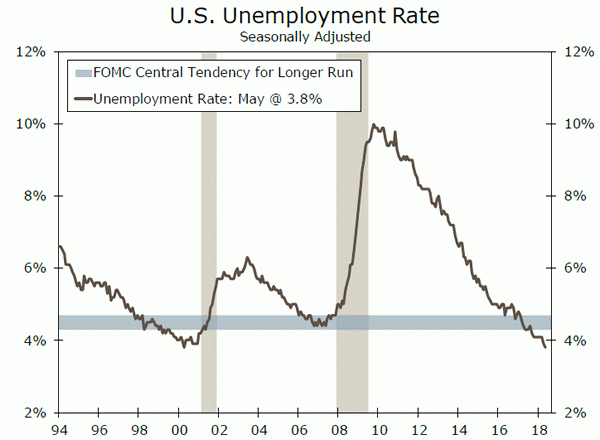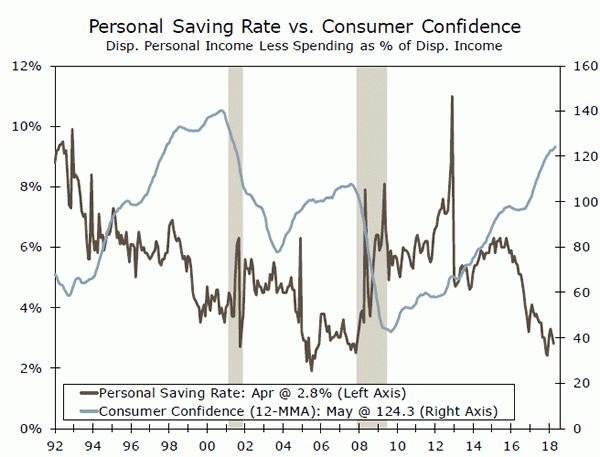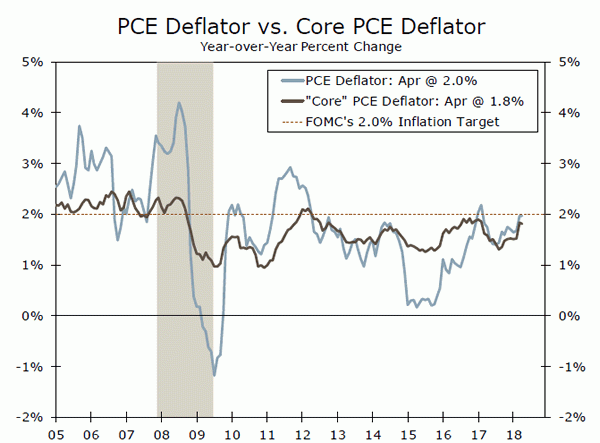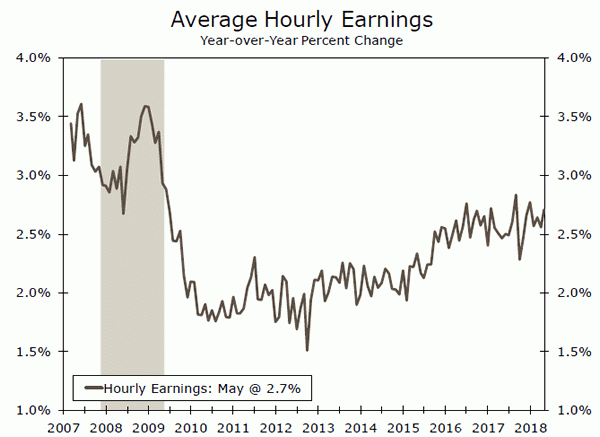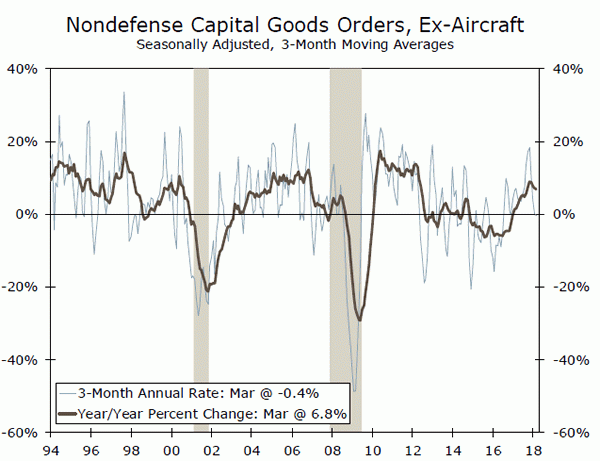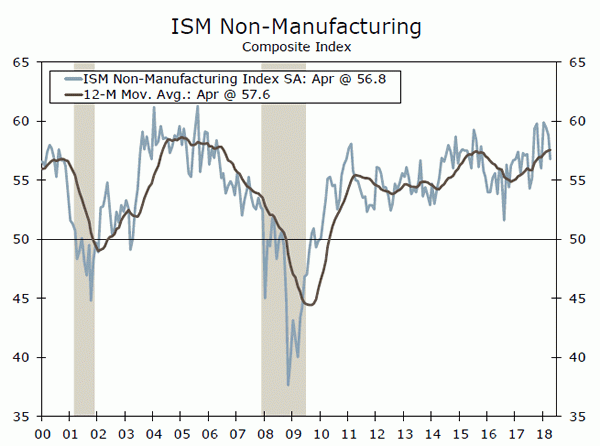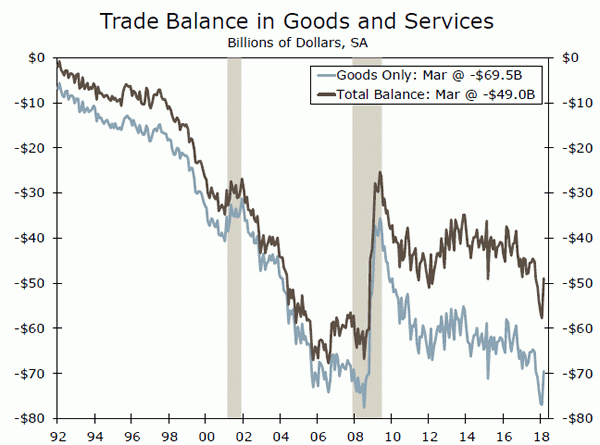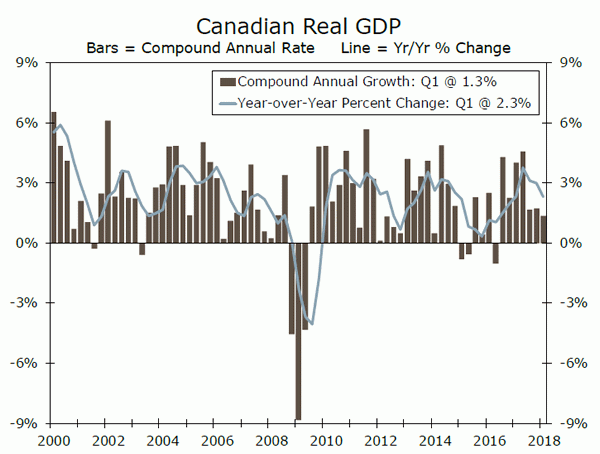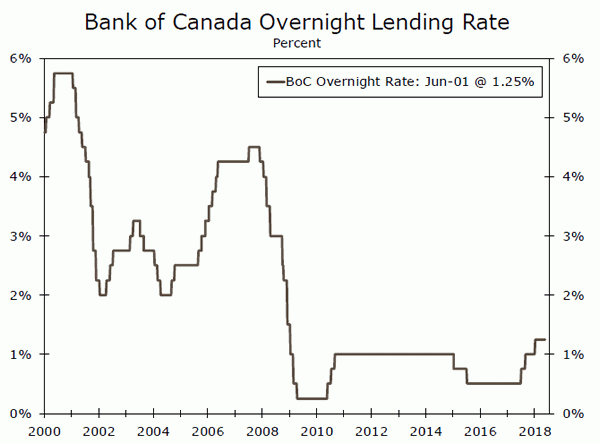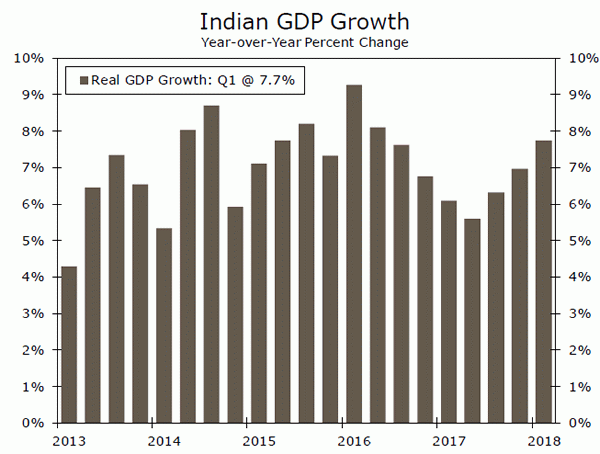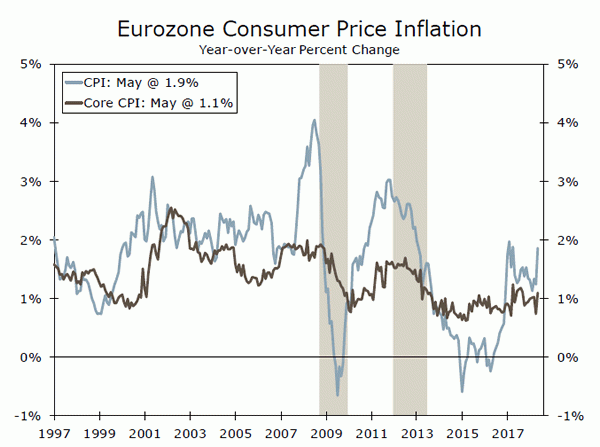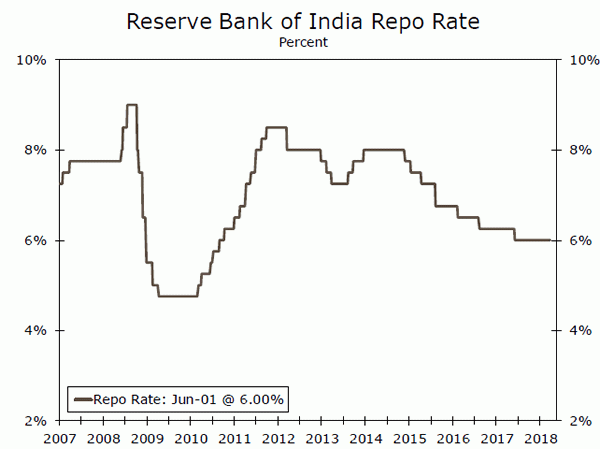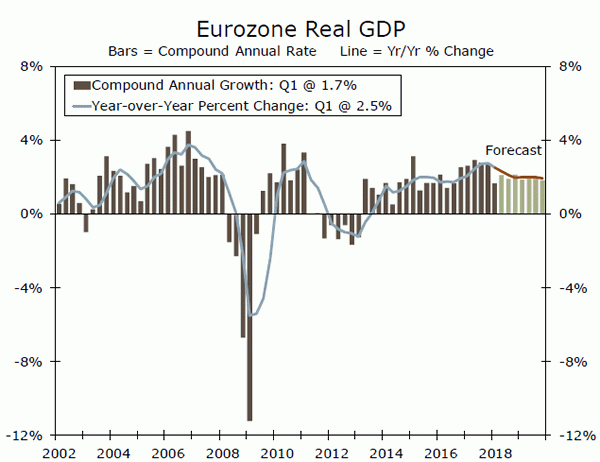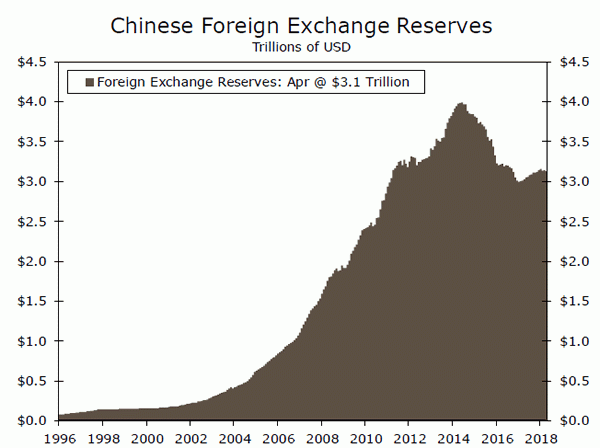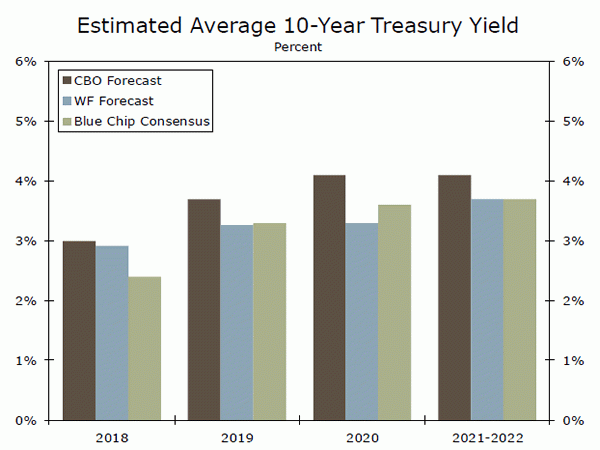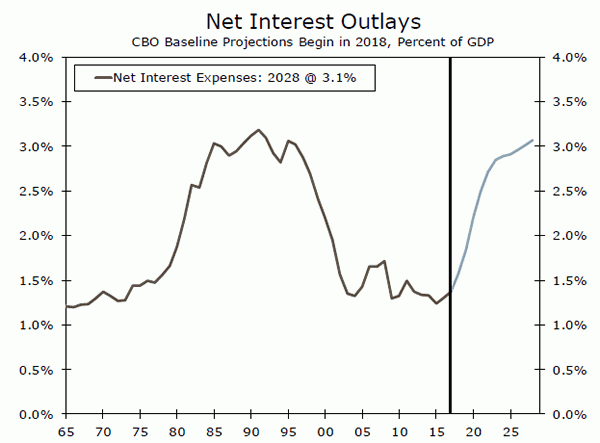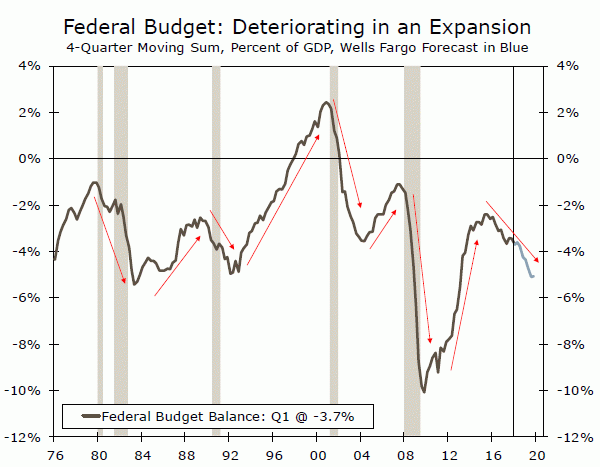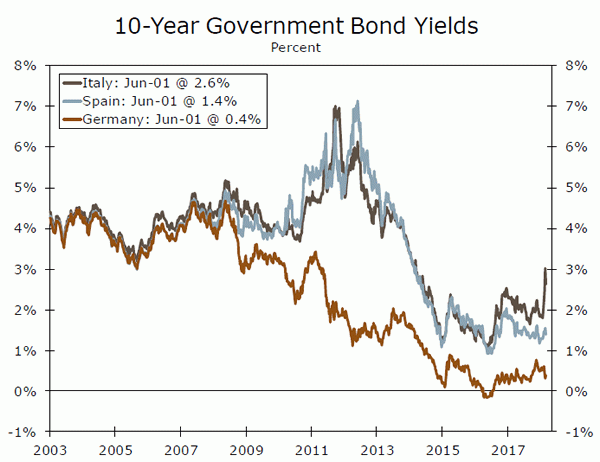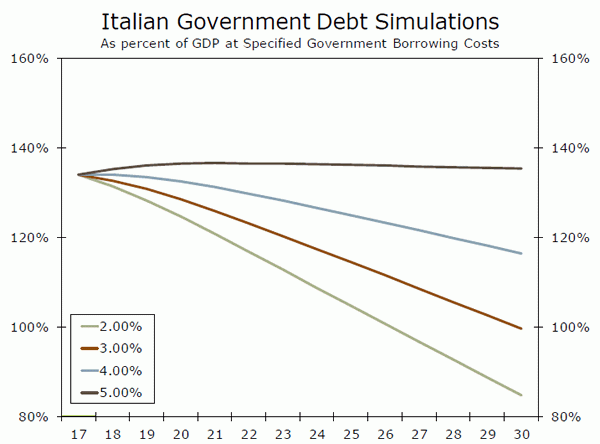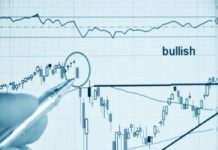U.S. Review
Heading Into Summer, Labor Market Is Already Hot
- The labor market strengthened further in May, with employers adding 223,000 new jobs, the unemployment rate falling to 3.8 percent and wages rising 0.3 percent.
- The household saving rate edged lower, as consumer spending outpaced income for a second straight month. The boost to real disposable income from the tax reform is under pressure from rising inflation as gasoline prices have continued to climb.
- Consumers continue to maintain a high degree of confidence in the economy, with the Conference Board’s measure increasing 2.4 points in May.
Heading Into Summer, Labor Market Is Already Hot
Despite a holiday-shortened weak, there was a lot to learn in recent days about the state of the American consumer. Consumer’s confidence in the economy remained buoyant heading into summer, with the Conference Board’s measure rising 2.4 points. Households viewed both current and future economic conditions more favorably, while the labor differential – the share of households reporting jobs as “plentiful” minus the share reporting “hard to get” – pointed to an increasingly tight labor market.
Consumers’ optimism about the economy helped to fuel spending above and beyond income growth in April. Household spending rose 0.6 percent in April, while personal income rose 0.3 percent. Stronger spending has also been driven by the recent federal tax changes leading to lower withholding for many households. Income outpaced spending the first two months of the year when changes initially went into effect. Now with the tax savings accumulating (and more mild weather), households have stepped up spending. The saving rate, in turn, has fallen half a point since February, but at 2.8 percent remains above December’s 2.4 percent rate.
Spending has also been lifted in recent months by climbing gasoline prices. Although gas prices typically rise heading into the summer driving season, the average national price of a gallon of gas according to AAA was $2.72 in April, a 13 percent increase over last year. With gas prices having climbed another 6 percent in May, real household spending power is coming under pressure despite the recent boost tax changes have provided to disposable income.
Inflation, measured by the PCE deflator, rose 0.2 percent in April, keeping it at 2.0 percent year-over-year. That is only the fourth month in the past six years inflation has been at or above the Fed’s target. Beyond gasoline prices, however, inflation is firming. The core PCE index rose more than expected in April (0.2 percent), and, at 1.8 percent, is also closing in on the Fed’s target.
Rising inflation has made the need for stronger wage growth all the more pressing for workers. In May, average hourly earnings growth rose 0.3 percent, bringing the year over year rate up to 2.7 percent. Although that is still a bit below the pace registered a few months back, strong hiring continues to support aggregate income growth among households. The income proxy – total hours worked multiplied by average hourly earnings – has improved to a 5.4 percent annualized pace over the past three months, compared to 3.3 percent at the start of the year.
Employers added 223,000 new jobs in May, with gains widespread across industries. The diffusion index – a measure of the net share of industries adding jobs – improved to 67.6 in May and has been trending up over the past year. The supply of labor looks increasingly scarce and will likely place additional upward pressure on compensation costs. The unemployment rate fell to 3.8 percent, which matches the low of the 1991-2001 cycle. Labor force participation also ticked down, highlighting that structural challenges to bringing more workers back into the labor force linger.
U.S. Outlook
Factory Orders • Monday
Factory orders beat expectations and increased 1.6 percent in March. Much of the gain, however, was attributable to civilian aircraft orders, which surged 44.5 percent for the month. Core capital goods orders and shipments both declined, which is not a positive sign for future growth in equipment spending. Orders for defense aircraft, motor vehicles, construction machinery, and industrial machinery were also all down for the month.
Factory orders have increased in seven of the past eight months, and capital spending has been adding to topline GDP growth in each of the past six quarters. However, the fastest quarterly growth rates for capital spending may well be behind us. The declines in core capital goods spending suggest limited upside for future capital spending at this late stage of the economic cycle; however, there is scope for equipment spending to remain supportive of growth in the coming quarters.
Previous: 1.6% Wells Fargo: -0.4% Consensus: -0.4% (Month-over-Month)
ISM Non-Manufacturing • Tuesday
The ISM non-manufacturing index fell in April; however, it remained solidly in expansion territory at 56.8. New orders improved during the month, while current activity moderated and delivery times lengthened. Input prices also increased as cost pressures continued to pick up outside of the manufacturing sector. The employment component of the index also softened compared to the impressive pace posted over the past few months. While the hiring component of the index eased in April, this is largely in-line with our view that there is little slack left in the labor market and employment growth should continue to downshift.
Activity outside the industrial sector expanded at a slower pace in April. Despite registering more temperate activity, the forwardlooking new orders index increased last month, and the composite index remains at a level consistent with solid economic growth. We expect the composite index to trend higher this month.
Previous: 56.8 Wells Fargo: 58.0 Consensus: 57.8
Trade Balance • Wednesday
The U.S. trade deficit narrowed to $49 billion in March. The drop followed a nine-year high of $57.7 billion in February. A $4.2 billion increase in exports of goods and services, alongside a $4.6 billion decrease in imports, led March’s significant drop in the trade deficit. Two transient factors likely played an outsized role in the sharp decline, namely a jump in volatile aircraft orders as well as port closures due to the timing of the Chinese New Year.
Real net exports were supportive of first quarter GDP growth. Exports of goods rose at solid pace in both February and March which suggests exports should continue to add to GDP growth in the second quarter. Meanwhile, imports fell 1.6 percent in March and are expected to have a limited effect on second quarter GDP. Looking ahead, global economic growth should continue to boost exports, while solid domestic demand will pull in imports. Overall, we expect real net exports to be neutral to GDP growth in the near term.
Previous: $-49.0B Wells Fargo: -$48.6B Consensus: $-51.3B
Global Review
Global Outlook Remains Positive Amid Italy Turmoil
- It was a busy week in the global economy, with the Italian political and debt challenges taking center stage, a topic we explore in more detail on page 7.
- Outside of Italy, a slew of countries reported Q1 real GDP growth. Economic growth in Sweden, Switzerland and India topped expectations, while Canadian growth was a bit softer than expected.
- Eurozone inflation, which had softened over the past few months, showed some signs of a turnaround in May. A stronger inflation print provides European Central Bank hawks with a bit more ammunition headed into the critical June 14 meeting.
Global Outlook Remains Positive Amid Italy Turmoil
It was a busy week in the global economy, with the Italian political and debt challenges taking center stage, a topic we explore in more detail on page 7. Outside of Italy, a slew of countries reported first quarter GDP this past week. Starting with our neighbors to the north, Canadian GDP growth slowed to a 1.3 percent annualized pace in Q1, a continuation of the slowdown that began in H2-2017. Housing investment declined at a 7.2 percent annualized pace, subtracting 0.5 percentage points off of headline growth as the Canadian housing sector continues to roll over.
That said, the slowdown that has occurred over the past few quarters came on the heels of robust H1-2017 economic growth that helped drive 2017 full-year GDP growth in Canada to its fastest pace since 1998. We do not expect the Canadian economy to continue slowing, and it appears the Bank of Canada (BoC) is in agreement. At its meeting this week, the BoC remarked that first quarter economic activity “appears to have been a little stronger than expected,” and cited more robust exports of goods, solid labor income growth and recovering investment as evidence for improving conditions. In our view, the statement adopted a moderately more hawkish stance, and potentially signals a faster pace of rate hikes than previously anticipated.
Elsewhere, India’s economy accelerated for the third consecutive quarter, rising 7.7 percent year over year (middle chart). The data were supportive of our view that India’s economy has turned the corner after an economic slowdown driven by structural reforms surrounding demonetization and the rollout of the goods and services tax. The Reserve Bank of India (RBI), which had been cutting its main policy rate over the 2015-2017 period to combat a slowdown in growth and inflation, has been on hold since last summer. With inflation in check and economic growth gaining momentum, the Reserve Bank of India seems content to assess the incoming data and let the recovery continue unperturbed.
In Europe, the Swiss economy strengthened further in Q1, with real GDP growing 2.2 percent year over year to surpass 2 percent for the first time since Q2-2016. The Swiss National Bank (SNB) probably does not want to get materially ahead of the European Central Bank’s (ECB) monetary policy, and we look for the ECB to tighten at a gradual pace. This means that the SNB will likely remain on hold through the end of the year in light of only slowly rising inflation and a gradual pickup in consumer spending. Swedish GDP also surprised to the upside. With the gain, real GDP growth in Sweden continued its slow but steady climb higher on a year-over-year basis, eclipsing the 3 percent mark for the first time in nearly two years.
Finally, Eurozone inflation, which had softened over the past few months, showed some signs of a turnaround in May (bottom chart). Decelerating prices and softer economic growth in Q1 led some to wonder whether the European Central Bank would really end its asset purchases by year’s end. While this week’s inflation print is just one data point and political tensions continue to cloud the outlook, a stronger inflation print provides ECB hawks with a bit more ammunition headed into the critical June 14 meeting.
Global Outlook
Reserve Bank of India • Wednesday
The Reserve Bank of India (RBI) left its main repurchase rate unchanged at 6.00 percent at its April 5 meeting, citing stronger economic growth, yet moderating inflation as factors underpinning its decision. Economic growth in India has indeed strengthened, with data released this week showing that real GDP grew a strong 7.7 percent in Q1, with particular strength in investment spending and private consumption. In terms of prices, the RBI targets CPI inflation of 4 percent, and inflation has come down to 4.6 percent in April. But volatile food and energy prices along with the still-recent pickup in GDP growth have likely led the RBI to proceed with caution, compounded by concerns over rising global protectionism. The consensus looks for the RBI to again leave rates unchanged at next week’s meeting, although the RBI has also cited a shrinking output gap and generally positive economic outlook that should be supportive of gradual rate hikes in the coming quarters.
Previous: 6.00% Consensus: 6.00%
Eurozone GDP • Thursday
Real GDP in the Eurozone rose 0.4 percent in Q1’s preliminary release, a slowdown from the 0.7 percent rate registered in Q4. Next week’s release will include the final Q1 numbers along with demandside detail. Personal consumption likely slowed in Q1, as growth in real retail sales has been lackluster so far this year. Low CPI inflation has been a roadblock for the European Central Bank (ECB) on its path towards policy normalization, however inflation is beginning to show signs of upward momentum, rising 1.9 percent in May’s preliminary release. Next week’s GDP release will provide another welcome data point for the ECB, especially in light of recent political tensions in Italy and Spain. But in our view, it is too soon to make any reasonable judgement on the lasting effects of any political uncertainty. Economic growth in the Eurozone largely remains solid, and inflation should continue to pick up, giving the ECB time to continue its slow-and-steady approach to removing accommodation.
Previous: 0.4% Wells Fargo: 0.4% Consensus: 0.4% (Quarter-over-Quarter)
Chinese FX Reserves • Thursday
After building up its stockpile of foreign exchange (FX) reserves to nearly $4 trillion in 2015, the Chinese government has since bought its own currency and sold roughly $1 trillion in foreign currencies. This move came in an attempt to counteract downward pressure on the Chinese renminbi after the broader economy decelerated in 2015-2016 as the government reined in rampant credit growth. While China’s FX reserves have since stabilized over the past year, currently at $3.1 trillion in April, more recent trade tensions between the U.S. and China are not without mentioning in terms of possible effects on China’s monetary position. China is the largest foreign holder of U.S. Treasury securities, which are mainly held by the government to back its stockpile of FX reserves. Although we find it unlikely that recent trade uncertainty has had a material impact on China’s Treasury purchases thus far, China’s large stake in U.S. debt and relatively high level of FX reserves remain areas to watch.
Previous: $3.1 Trillion Consensus: $3.1 Trillion
Point of View
Interest Rate Watch
Benchmark Yields in an Above Average Length Economic Cycle
As illustrated in the top graph, our outlook is for a drift upward in the ten-year U.S. treasury benchmark yield. While modest by economic cyclical standards, the implications for both fiscal and monetary policy actions are significant. The future is not a repeat of the past.
Confluence to Conflict
For prior years of this economic cycle the confluence of modest growth and modest inflation meant a period of flat inflation expectations and a steady monetary policy of low interest rates.
However, we anticipate a period of conflict between tighter monetary policy and increased deficit financing. Monetary policy is expected to lean against the economic expansion by raising the funds rate as the unemployment rate persists below what the Fed anticipates is their full employment rate. Meanwhile, U.S. Treasury finance will support an expansionary fiscal policy. Our expectation is that the federal deficit will rise from $775 billion in FY 2018 to $1.1 trillion in 2019 while anticipating a higher deficit in the following years.
This conflict of tighter monetary policy and expansionary fiscal policy supports the case for higher interest rates and, unfortunately, rising net interest outlays in the federal budget (middle graph).
Of Course, This Is the Optimistic Case
Sorry, that was the optimistic case. Submitted for your approval, consider the bottom figure. What is critical is the inconsistency of the budget outlook with the state of the economy. The budget deficit historically exhibits countercyclical behavior–as the expansion ages, the deficit shrinks (see mid-1980s, mid-1990s and even the last decade). But this expansion is different – even more so beginning in 2016. Our concerns are magnified given the policy conflicts we see and the additional non-zero possibility of a recession.
Unfortunately, recessions do not provide forward guidance on their appearance. In the short-run, the next six to nine months, we calculate the probability of recession as very low (<5 percent) but remain aware of the risks given the limited six-nine month horizon. For decision makers, the problem remains that policy conflict at this stage of the business cycle, compounded by unusual fiscal policy timing, raises the risk profile.
Credit Market Insights
Borrowing Costs Limit Refinancing
Rising interest rates are making refinancing increasingly less attractive for homeowners. The average rate on a 30-year mortgage was at a seven-year high of 4.86 percent during the week of May 18, and slipped to its second highest level of 4.84 percent last week.
Higher rates continued to negatively impact mortgage demand last week, as mortgage application volume declined for the sixth consecutive week. Higher rates appear to be weighing more on refinancing than purchases. Purchase applications also fell slightly but the notable weakness was in the more rate-sensitive refinancing volume.
The Mortgage Bankers Association’s gauge of refinancing volume fell last week to its lowest point since 2000. Refinancing now accounts for the smallest share of mortgages since 2008. Higher mortgage rates can deter existing homeowners from refinancing to lower rates or cash out their equity.
Though purchase volume has been down in recent weeks, purchases have risen modestly over the year with home sales. Purchasing volume is somewhat less ratesensitive as sales are driven by stronger economic growth. Purchase volume has been more modest, however, as homebuyers are also facing an array of other challenges. Affordability is limiting options for many potential homebuyers, with home prices rising at the fastest pace since 2014. There is also a dearth of existing homes for sale. And high mortgage rates also make homeowners more hesitant to sell their current home and borrow for another at a higher rate.
Topic of the Week
Is the European Debt Crisis Back Again?
After three years of relative calm, volatility has returned to sovereign bond markets in the euro area due to political uncertainty in Italy and Spain (top chart). In a report published earlier this week, “Is the European Debt Crisis Rearing its Ugly Head Again?,” we find that renewed fiscal largesse could lead to a vicious circle of larger fiscal deficits, higher borrowing costs and slower economic growth.
In Italy, political uncertainty, which has been building since the inconclusive general election on March 4, came to a head this week when the Lega Nord, which hails from the right of the political spectrum, joined forces with the Five Star Movement, which tends to support leftist policies, to form the next government. In Spain, Prime Minister Rajoy lost a confidence vote and will be succeeded by Pedro Sanchez, leader of the Socialist Party. The new government likely will be weak because the Socialists must rely on a number of regional parties to form a majority in parliament.
Although debt dynamics in Spain and Italy have largely stabilized since the last Greek debt crisis in 2015, we consider several combinations of nominal GDP growth rates and government borrowing costs that would be needed to stabilize the debt-to-GDP ratios of each country at their current levels (bottom chart). We find that Italy has little room to ease fiscal policy significantly, given that its nominal GDP growth has remained lackluster in recent years. Italy’s government debt outstanding totals €2.3 trillion, and with its rank among the 10 largest world economies, a financial fire in Italy, should one start, may be difficult to extinguish. In Spain, stronger economic growth and a lower debt-to-GDP ratio gives its economy more room to accommodate fiscal changes, assuming current growth rates remain intact. Markets will be watching closely to see if the new governments in Italy and Spain enact policies that threaten debt sustainability in their respective economies. Stay tuned.




